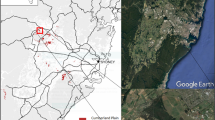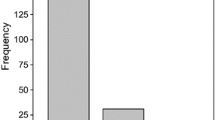Abstract
Dwarf mistletoes induce abnormal growth patterns and extreme changes in the biomass allocation of their hosts as well as directly parasitizing them for resources. Because biomass allocation can affect the resource use and efficiency of conifers, we studied the influences of dwarf mistletoe infection on above-ground biomass allocation of Douglas fir and western larch, and the consequences of such changes on whole-tree water use and water relations. Sap flow, tree water potentials, leaf:sapwood area ratios (A L:A S), leaf carbon isotope ratios, and nitrogen content were measured on Douglas fir and western larch trees with various degrees of mistletoe infection during the summer of 1996 in western Montana. Heavy dwarf mistletoe infection on Douglas fir and western larch was related to significant increases in A L:A S. Correspondingly, water transport dynamics were altered in infected trees, but responses were different for the two species. Higher A L:A S ratios in heavily infected Douglas firs were offset by increases in sapwood area-based sap flux densities (Q SW) such that leaf area-based sap flux densities (Q L) and predawn leaf water potentials at the end of the summer did not change significantly with mistletoe infection. Small (but statistically insignificant) decreases of Q L for heavily infected Douglas firs were enough to offset increases in leaf area such that whole-tree water use was similar for uninfected and heavily infected trees. Increased A L:A S ratios of heavily infected western larch were not offset by increases of Q SW. Consequently, Q L was reduced, which corresponded with significant decreases of water potential at the end of the summer. Furthermore, mistletoe-infection-related changes in A L:A S as a function of tree size resulted in greater whole-tree water use for large infected larches than for large uninfected trees. Such changes may result in further depletion of limited soil water resources in mature infected stands late in the growing season. Foliage from infected trees of both species had lower water use efficiencies than non-infected trees. Our results demonstrate substantial changes of whole-tree processes related to mistletoe infection, and stress the importance of integrating whole-tree physiological and structural processes to fully understand the mechanisms by which pathogens suppress forest productivity.
Similar content being viewed by others
Author information
Authors and Affiliations
Rights and permissions
About this article
Cite this article
Sala, A., Carey, E. & Callaway, R. Dwarf mistletoe affects whole-tree water relations of Douglas fir and western larch primarily through changes in leaf to sapwood ratios. Oecologia 126, 42–52 (2001). https://doi.org/10.1007/s004420000503
Received:
Accepted:
Published:
Issue Date:
DOI: https://doi.org/10.1007/s004420000503




